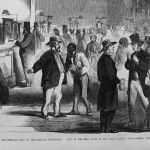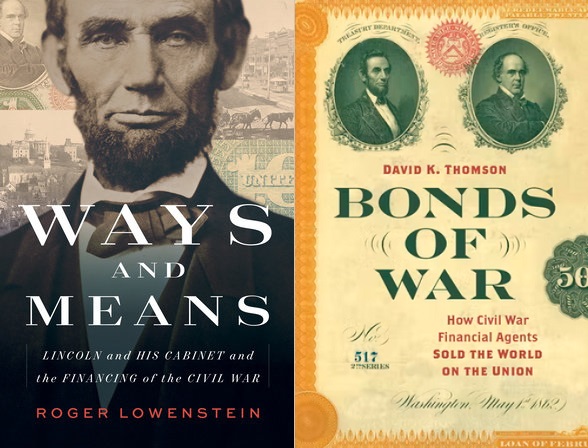One Review, Two Books: Ways and Means and Bonds of War
“In January [1865], economist Amasa Walker wrote on ‘men and money,’ the two elements that Walker believed were ‘indispensable to war.’ Walker added, ‘You may, indeed, have money without men, but cannot have men without money.’”1 – David Thomson in Bonds of War

How did a government that was spending $1 million per week in the 1850s, and which brought in a significant portion of its income as customs duties from ports in states that seceded, manage to pay for a war that was costing up to $3.5 million per day by the end?2 Two books released this year have sought to answer that question: Ways and Means: Lincoln and His Cabinet and the Financing of the Civil War by Roger Lowenstein, and Bonds of War: How Civil War Financial Agents Sold the World on the Union by David K. Thomson.
Both works touch on the same tripod of government financing of the war: the sale of bonds, the introduction of paper currency that became known as “greenbacks”, and increased taxes, particularly the first United States federal income tax. Similarly, both books closely follow Treasury Secretary Salmon P. Chase and Northern financier Jay Cooke (a fascinating character in American history who I can’t avoid this year; he also features prominently in Megan Kate Nelson’s new book, Saving Yellowstone).
 For sharing a common topic, the books do tread considerably different ground. Way and Means takes the time to discuss Confederate financing in moderate depth, often as a foil and contrast to Union efforts. He speaks to inflation across the South as the war dragged on, and contrasts the approaches of the Davis and Lincoln governments. I love a good counterfactual, and appreciate how he occasionally hints at alternative paths the Confederacy could have taken, particularly in using cotton to finance the war early on, before the blockade was fully in place.
For sharing a common topic, the books do tread considerably different ground. Way and Means takes the time to discuss Confederate financing in moderate depth, often as a foil and contrast to Union efforts. He speaks to inflation across the South as the war dragged on, and contrasts the approaches of the Davis and Lincoln governments. I love a good counterfactual, and appreciate how he occasionally hints at alternative paths the Confederacy could have taken, particularly in using cotton to finance the war early on, before the blockade was fully in place.
Lowenstein devotes an entire chapter to the growth of the federal government during the Civil War, distinct from the war effort. While any student of the war is familiar with the Republican Party’s anti-slavery roots, less well-known is the platform of internal improvements that Lincoln and his fellow Republicans ran on. An entire chapter is dedicated to what he terms the “Forgotten Congress,” the 37th Congress that was in power in 1861 and 1862 that significantly changed how our federal government is experienced by the average citizen. The Homestead Act of 1862, the creation of the Department of Agriculture, the Morrill Land-Grant College Act of 1862, and the Pacific Railway Act would all significantly expand the reach of the federal government while being largely tangential to the war effort itself.

Bonds of War, on the other hand, dives quite deeply into one piece of the financial tripod of bonds, taxes and greenbacks. As the title suggests, Thomson focuses almost exclusively on the bonds that funded two-thirds of the war effort, and foreshadowed the financing of the World Wars.
His research into foreign purchases of Union bonds is incredibly in-depth and thoroughly researched. He places a particular emphasis on bond purchases in the German states, which was facilitated by close relationships between German immigrants to the Union and German bankers remaining in Europe. While conceding the records are too poor to pin down an exact number, Thomson cites estimates that anywhere from $150M to $800M of Union debt was held in Europe – a considerable portion of the $3 billion that the war cost.3
Throughout his work, Thomson also weaves a compelling thread of the bonds representing a democratization of a war effort, in contrast to past wars being funded by financial elites. He places an intense emphasis on the idea of buying low value bonds, $50 at a time, as representing average citizens from diverse walks of life – women, immigrants, African Americans and Native Americans – buying into the enterprise of the war. He writes, “These people quite literally ‘bought in’ to the war on a level unseen in American history – asserting notions of civic inclusion and duty in the process.”4 He even discusses how the sale of Union war bonds spread into the Confederacy itself.
As someone without any background in finance, I found that both authors did an excellent job keeping their work accessible and engaging. Ways and Means is a particularly narrative-driven work that leans heavily on the character of Secretary Chase to keep the reader bought in; of the two, I would read this first as an introduction to the topic, and be more likely to recommend it to a friend with a more casual interest in history. But I think you’d be missing the full story if you didn’t follow it by reading Bonds of War, and I expect I’ll be reaching for that book regularly as a reference.
Ways and Means: Lincoln and His Cabinet and the Financing of the Civil War
By Roger Lowenstein
Penguin Press, 2022, $30.00 hardcover
Bonds of War: How Civil War Financial Agents Sold the World on the Union
By David K. Thomson
University of North Carolina Press, 2022, $29.95 paperback
- Thomson, David K. Bonds of War: How Civil War Financial Agents Sold the World on the Union. University of North Carolina Press, 2022, 135.
- Klein, Lloyd W. “US Government Financing of the Civil War.” Emerging Civil War, July 27, 2021.
- Thomson 114.
- Thomson 56.

I thoroughly enjoyed “Ways and Means.” Now I will need to read “Bonds of War.”
Thanks for the kind write up Patrick!
Thoroughly enjoyed “Bonds of War.” Thanks for all your hard work in researching it.